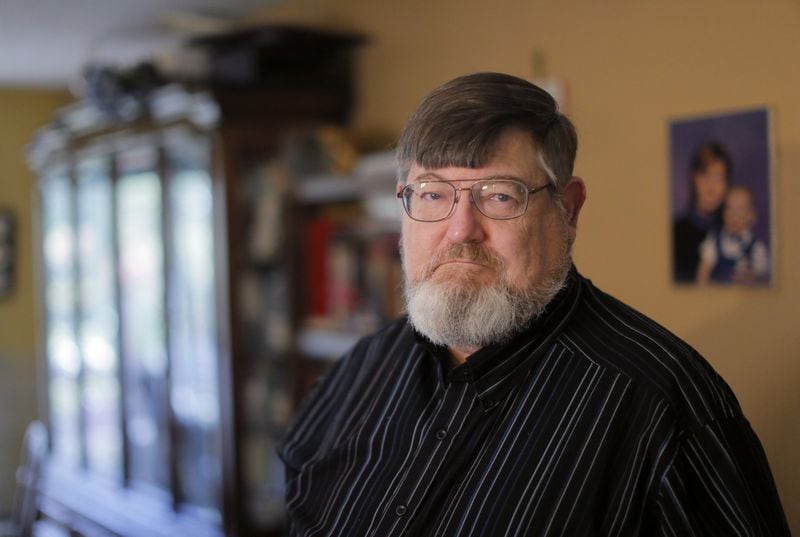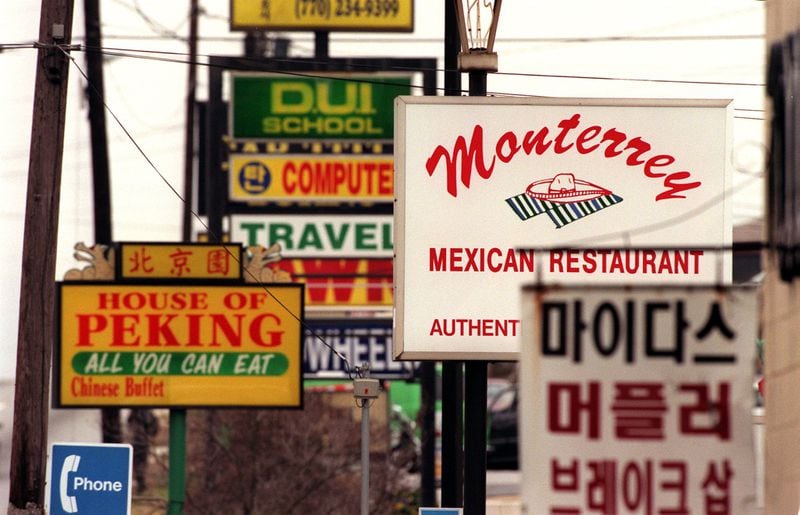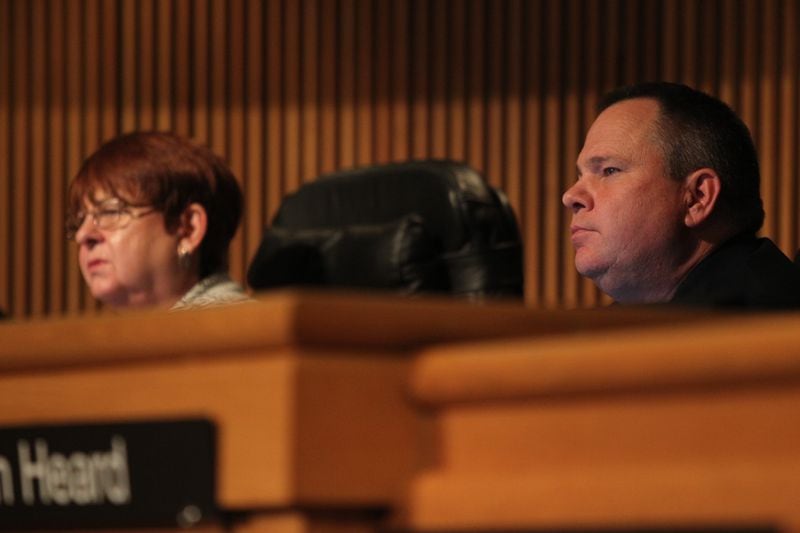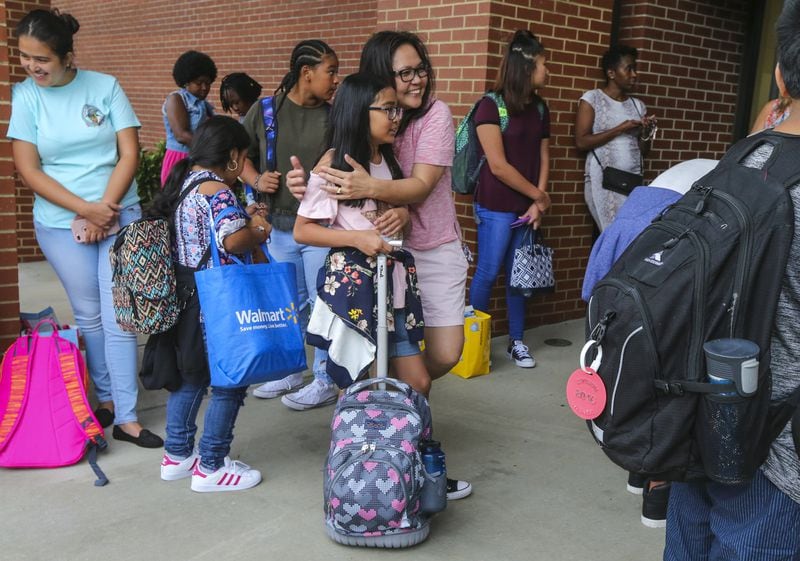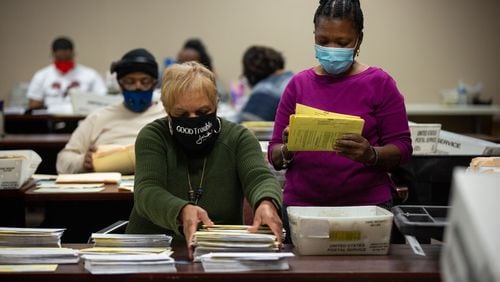The paved part of Davenport Road ended at his family’s driveway. They had 12 acres, including one that was dedicated to a garden big enough to feed them all for a while, should the need arise. There were chickens in the front yard.
When Dan Franklin was growing up in the 1950s and ’60s, the Duluth area — and the rest of Gwinnett County, for that matter — was farmland and simple living. It was a few thousand folks spread out across 400-something square miles northeast of Atlanta. Just about everyone knew each other, and just about everyone was white.
Credit: Bob Andres
Credit: Bob Andres
None of that is the case any longer, not by a long shot. Gwinnett is a booming suburb with one of the most diverse communities in the Southeastern United States. And Franklin, who moved from Davenport Road to another part of Gwinnett decades ago, admits he sometimes feels like a stranger in the county where he's lived for all 65 years of his life.
“Especially,” he said, “when I go back to Duluth now and I can’t read the signs. I can’t make out the letters because half of them are in, I guess it’s Korean.”
For many longtime Gwinnett residents, the majority of whom are white, the county’s almost simultaneous explosion in size and diversity can be a difficult thing to reckon with. In some, that reckoning can manifest itself as racism, but it can also be a different sort of thing — a longing for the South, the home, that they grew up with.
Today, the Davenport Road of Franklin’s childhood is not gravel and garden rows but asphalt and apartments that stretch the full length between Buford Highway and Old Norcross Road. It’s punctuated on one end by auto body shops with signs in Korean, and on the other by a strip mall that’s home to “Waba Karaoke” and a hair salon promising “Japanese magic.”
“It’s just not anywhere like what it was when I was growing up,” Franklin said.
‘FASCINATING CASE STUDY’
Like Franklin, Bill Holt grew up in a different Gwinnett.
His grandfather ran Monfort Drugs in its original location on Lawrenceville’s downtown square (a spot on the corner of E. Crogan and N. Perry streets that’s now home to the popular McCray’s Tavern). Judy Jordan Johnson — the current mayor of Lawrenceville, which will have a $182 million city budget in 2018 — was his high school geometry teacher.
Holt, 50 and white, is now an urban planner and a professor at Birmingham-Southern College in Alabama, where his areas of interest include sociology and community development. In 2010, he penned a paper titled “Gwinnett Goes Global: The changing image of American suburbia.”
He calls his native county a “fascinating case study.” That today’s Gwinnett is home to 900,000 people and crowded, sprawling highways is a fact that’s inseparably linked to it having more combined minority residents than white ones. About 39 percent of Gwinnettians are white, 28 percent are black, 21 percent are Hispanic and 12 percent are Asian.
Gwinnett lost its ruralness at the same time it became a community where nearly a quarter of its residents are foreign-born.
“It’s a place that’s grown so fast,” Holt said, “and now has a lot of issues to deal with, with that growth.”
Those issues include income inequality, a lack of affordable housing and, perhaps surprisingly, homelessness. But unlike many of its metro Atlanta counterparts, the modern version of Gwinnett has largely avoided significant public incidents of racial tension.
Until this year, at least.
‘A STRONGER COMMUNITY’
Dan Franklin left his childhood home on Davenport Road and moved to Lawrenceville after getting out of the military in the mid-1970s. Even then, living in Lawrenceville was like living in the boonies — he remembers neighbors raising cows and hogs and keeping not-so-secret moonshine stills.
Now there’s subdivision after subdivision after subdivision surrounding his. There are Hispanic grocery stores and bakeries. And nearby Central Gwinnett High School has a student body that’s overwhelmingly black and Hispanic.
Franklin, a lab technician, says he’s one of the few native English speakers on his street of aging, low-slung homes with spacious fescue yards.
It’s hard to say, definitively, how Gwinnett became the community it is today. But the general — and generalized — train of thought goes something like this:
- In 1970, a few years before Franklin joined the military, cable manufacturer Western Electric opened a facility off I-85 near Jimmy Carter Boulevard. It was the first major industry to come to the county and it brought about 2,500 jobs — jobs filled, in many instances, by well-paid Gwinnett newcomers (mostly white, but some black) who wanted good homes and good schools for their kids.
- A housing boom was born, and longtime locals started selling family farms for other developments.
- Construction jobs flourished in the late '80s and into the '90s. The migrant workers from Mexico and Central America who filled those roles eventually sent for their families and put down more permanent roots.
- At the same time, the international character of DeKalb County's Buford Highway corridor — a haven for Asian and Hispanic immigrants — began stretching deeper into Gwinnett.
- The 1996 Atlanta Olympics triggered a population boom — and international immigrants — in the Atlanta area. With a school system that was already beginning to be considered among the best in the Southeast, Gwinnett County was a popular destination.
- The school system (and lower home prices) made Gwinnett an enticing spot for black residents from DeKalb County, the city of Atlanta and elsewhere in the region.
In 1970, Gwinnett County had just over 72,000 residents, almost all of them white. Gwinnett is projected to be Georgia's most populous county by 2040, with more than 1.35 million people — less than 30 percent of whom will be white.
“We happen to think (diversity) is a good thing, that it’s going to make a stronger community going forward,” Gwinnett County Commission Chairman Charlotte Nash said.
Nash, who is white, lives in the northeastern Gwinnett area of Dacula, where her family’s history dates back about 200 years. She and her husband raise livestock and are no strangers to longing for some aspects of the old days. But she’s been visibly pained by the county’s recent run of race-related issues.
‘A LONG WAY TO GO’
Gwinnett’s relative racial tranquility has been repeatedly disrupted this year.
In April, two white Gwinnett County police officers were fired after cellphone videos shot by bystanders showed them kicking and striking a black motorist, Demetrious Hollins, during a traffic stop.
The incident caused a social media uproar, but the police department stemmed the tide by dismissing Sgt. Michael Bongiovanni and Master Police Officer Robert McDonald just hours after the cellphone videos emerged.
Both officers were also arrested and are facing criminal charges.
Three months earlier, on Martin Luther King Jr. weekend, white Gwinnett County Commissioner Tommy Hunter took to Facebook. He wrote that civil rights icon and U.S. Rep. John Lewis was a "racist pig." His comments triggered an ethics complaint, a public reprimand and commission meeting protests that still occasionally pop up 11 months later.
At least three other local officials or candidates have drawn heat for their own racially charged social media posts in recent months. Another county employee was suspended for referencing a racial slur at a work event.
Sam Park is a state representative whose Lawrenceville-based District 101 includes part of the intersection where Hollins was beaten by police. Just 31 years old, Park is the first openly gay man elected to Georgia’s General Assembly and the son of Korean immigrants.
He said he was “disheartened” by the Hollins incident and the Hunter situation. But Park, a Democrat, is also optimistic.
Gwinnett did not have those types of problems before this year’s incidents, Park said. “And that says something for our county.”
Gabe Okoye, a Nigerian immigrant who has lived in Gwinnett since 1992, is more guarded in his assessment.
“The progress is not evenly spread, but it’s there all the same,” said Okoye, president of Gwinnett’s Democratic Party. “I would say that the state of racism in Gwinnett continues to improve. But it still has a long way to go.”
‘I DON’T FEEL IT’
On a recent fall day, 19-year-old Alexis Gonzales stood outside the cellphone store where he works. The store is tucked in an aging strip mall a few miles west of Dan Franklin’s house in Lawrenceville — the county seat of Gwinnett, a county that’s home to about 171,000 Latinos.
A taqueria, a supermercado, a Dominican barber shop and “Tina’s African Hair Braiding” are just a few of the cellphone store’s neighbors.
Gonzales, an American citizen of Mexican heritage, said he and his friends sometimes receive looks “like they think we’re criminals” when they venture into “white neighborhoods” outside Gwinnett County. He said he’s seen little racism in his day-to-day life near home.
But that doesn’t lead him to believe bigotry will become extinct in Gwinnett.
“There’s still going to be white folks who hate on Hispanics,” he said.
Two Gwinnett cities, Norcross and Loganville, elected their first-ever non-white mayors this month. One of them, Craig Newton of Norcross, is black. The other, Rey Martinez of Loganville, is of Cuban heritage.
But advocates still believe Gwinnett’s minority populations remain woefully underserved and underrepresented.
In August 2016, the Georgia Association of Latino Elected Officials and the Georgia NAACP filed a lawsuit challenging the way Gwinnett County's commission and school board districts are drawn. The county has never had a non-white member on either entity, and the groups allege that their district maps were drawn specifically to thwart the voice of minority voters.
That suit is still being adjudicated, but advocacy groups have claimed another victory in the meantime.
The U.S. Census Bureau in December gave Gwinnett County for the first time a designation that mandates it offer Spanish-language voting information — everything from registration forms and online info to ballots.
Tarece Johnson recently moved back to Lawrenceville after what she described as “racial issues” in the rural Pennsylvania community where she and her children briefly resided. Black and Jewish, Johnson has lived in New York, Puerto Rico and elsewhere.
Johnson said that, in a dozen or so years of living in Gwinnett, she has never had to deal with outright racism. Part of that, she thinks, may be that different communities “self-segregate,” which is a very real phenomenon in Gwinnett.
But regardless …
“I go to the store, I don’t feel it,” Johnson said. “I go to restaurants, I don’t feel it. … I don’t feel it in Gwinnett County.”
‘SORT OF A THROWBACK’
Dennis Elm has not dealt well with the change that’s come to Gwinnett.
Inside the Stone Mountain-area home where he’s lived since 1984 — just inside Gwinnett’s border with DeKalb, in a predominantly black area — he said he’s tired of being beat over the head with “civil rights crap.”
The 77-year-old white man, who has attended multiple County Commission meetings to defend Hunter, said everyone should be treated the same.
But in the same breath he admitted he’s “no great lover of the black people.” Ask him about Gwinnett’s future, and he says it “looks like white flight.”
Credit: John Spink
Credit: John Spink
The Atlanta Regional Commission indeed projects Gwinnett’s white population will be the slowest-growing demographic between now and 2040. But it will still grow by more than 40,000 people. (By comparison, the county’s Hispanic population is projected to grow by more than 300,000, about 64 percent of Gwinnett’s expected overall increase.)
At least openly, though, few in the older guard share Elm’s more extreme views.
Diana Preston, who is white, has lived in the Gwinnett city of Lilburn since 1970. She was its mayor during an ugly chapter in the county’s history, when her (ultimately successful) attempt to sell family land to a mosque triggered months of protests and wild allegations.
“I think everybody thinks of the old times as the better times — and sometimes when you really drill down into it, they weren’t really better times,” Preston said.
Dan Franklin doesn’t always recognize the community where he’s lived for 65 years, or the neighborhood he’s called home for more than four decades. And it can feel odd being a minority.
But Franklin said his diverse group of neighbors, and the character and culture they bring, don’t really bother him.
“Except for the rooster.”
That rooster, Franklin said, lives in a Hispanic neighbor’s yard, and it crows at all hours of the night and early morning. It’s a nuisance.
Then again, maybe it’s a little piece of what Gwinnett used to be.
“It’s sort of a throwback,” Franklin said, “listening to a rooster next door, crowing in the middle of the night.”
MYAJC.COM: REAL JOURNALISM. REAL LOCAL IMPACT.
The AJC's Tyler Estep keeps you updated on the latest happenings in Gwinnett County government and politics. You'll find more on myAJC.com, including these stories:
Never miss a minute of what's happening in Gwinnett politics. Subscribe to myAJC.com.

